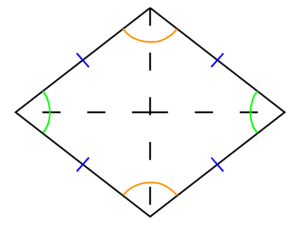Rhombus
Jump to navigation
Jump to search
A rhombus is a polygon of four sides of equal length. The angles of each pair of opposite vertices are equal. A rhombus is a special case of a parallelogram where all four sides are of equal length. A square is a special case of rhombus, where all four vertex angles are equal.
Properties
As with all quadrilaterals, the sum of the interior angles of a rhombus is 360 degrees; as with a parallelogram, it can be shown that the angles of opposite pairs of vertices are equal.
The perimeter of a rhombus is equal to 4 times the length of one side. The area of a square is equal to the length of the side multiplied by itself, multiplied by the sine of the angle between the sides.[1]
Any rhombus can tile a plane with no voids.
- ↑ Since the sum of the four angles is 360 degrees, and pairs of angles are equal, the sum of the angles of two adjacent vertices is 180 degrees. Since sin(180-x)=sin(x), the formula produces the same result no matter which vertex angle is chosen.
